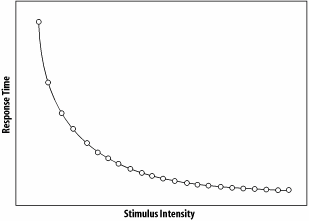Hack11.Why People Don t Work Like Elevator Buttons
|
Hack 11. Why People Don't Work Like Elevator Buttons
More intense signals cause faster reaction times, but there are diminishing returns: as a stimulus grows in intensity, eventually the reaction speed can't get any better. The formula that relates intensity and reaction speed is Pieron's Law. It's a common illusion that if you are in a hurry for the elevator you can make it come quicker by pressing the button harder. Or more often. Or all the buttons at once. It somehow feels as if it ought to work, although of course we know it doesn't. Either the elevator has heard you, or it hasn't. How loud you call doesn't make any difference to how long it'll take to arrive. But then elevators aren't like people. People do respond quicker to more stimulation, even on the most fundamental level. We press the brake quicker for brighter stoplights, jump higher at louder bangs. And it's because we all do this that we all fall so easily into thinking that things, including elevators, should behave the same way. 1.12.1. In ActionGive someone this simple task: she must sit in front of a screen and press a button as quickly as she can as soon as she sees a light flash on. If people were like elevators, the time it takes to press the button wouldn't be affected by the brightness of the light or the number of lights. But people aren't like elevators and we respond quicker to brighter lights; in fact, the relationship between the physical intensity of the light and the average speed of response follows a precise mathematical form. This form is captured by an equation called Pieron's Law. Pieron's Law says that the time to respond to a stimulus is related to the stimulus intensity by the formula: Reaction Time R0 + kI-b Reaction Time is the time between the stimulus appearing and you responding. I is the physical intensity of the signal. R0 is the minimum time for any response, the asymptotic value representing all the components of the reaction time that don't vary, such as the time for light to reach your eye. k and b are constants that vary depending on the exact setup and the particular person involved. But whatever the setup and whoever the person, graphically the equation looks like Figure 1-2. Figure 1-2. How reaction time changes with stimulus intensity 1.12.2. How It WorksIn fact, Pieron's Law holds for the brightness of light, the loudness of sound, and even the strength of taste.1 It says something fundamental about how we process signals and make decisionsthe physical nature of a stimulus carries through the whole system to affect the nature of the response. We are not binary systems! The actual number of photons of light or the amplitude of the sound waves that triggers us to respond influences how we respond. In fact, as well as affecting response time, the physical intensity of the stimulus also affects response force as well (e.g., how hard we press the button). A consequence of the form of Pieron's Law is that increases in speed are easy for low-intensity stimuli and get harder as the stimulus gains more intensity. It follows a log scale, like a lot of things in psychophysics. The converse is also true: for quick reaction times, it's easier to slow people down than to speed them up. Pieron's Law probably results because of the fundamental way the decisions have to be made with uncertain information. Although it might be clear to you that the light is either there or not, that's only because your brain has done the work of removing the uncertainty for you. And on a neural level, everything is uncertain because neural signals always have noise in them. So as you wait for light to appear, your neuronal decision-making hardware is inspecting noisy inputs and trying to decide if there is enough evidence to say "Yes, it's there!" Looking at it like this, your response time is the time to collect enough neural evidence that something has really appeared. This is why Pieron's Law applies; more intense stimuli provide more evidence, and the way in which they provide more evidence results in the equation shown earlier. To see why, think of it like this: Pieron's Law is a way of saying that the response time improves but at a decreasing rate, as the intensity (i.e., the rate at which evidence accumulates) increases. Try this analogy: stimulus intensity is your daily wage and making a response is buying a $900 holiday. If you get paid $10 a day, it'll take 90 days to get the money for the holiday. If you get a raise of $5, you could afford the holiday in 60 days30 days sooner. If you got two $5 raises, you'd be able to afford the holiday in 45 daysonly 15 days sooner than how long it would take with just one $5 raise. The time until you can afford a holiday gets shorter as your wage goes up, but it gets shorter more slowly, and if you do the math it turns out to be an example of Pieron's Law. 1.12.3. End Note
1.12.4. See Also
|
|
EAN: N/A
Pages: 159